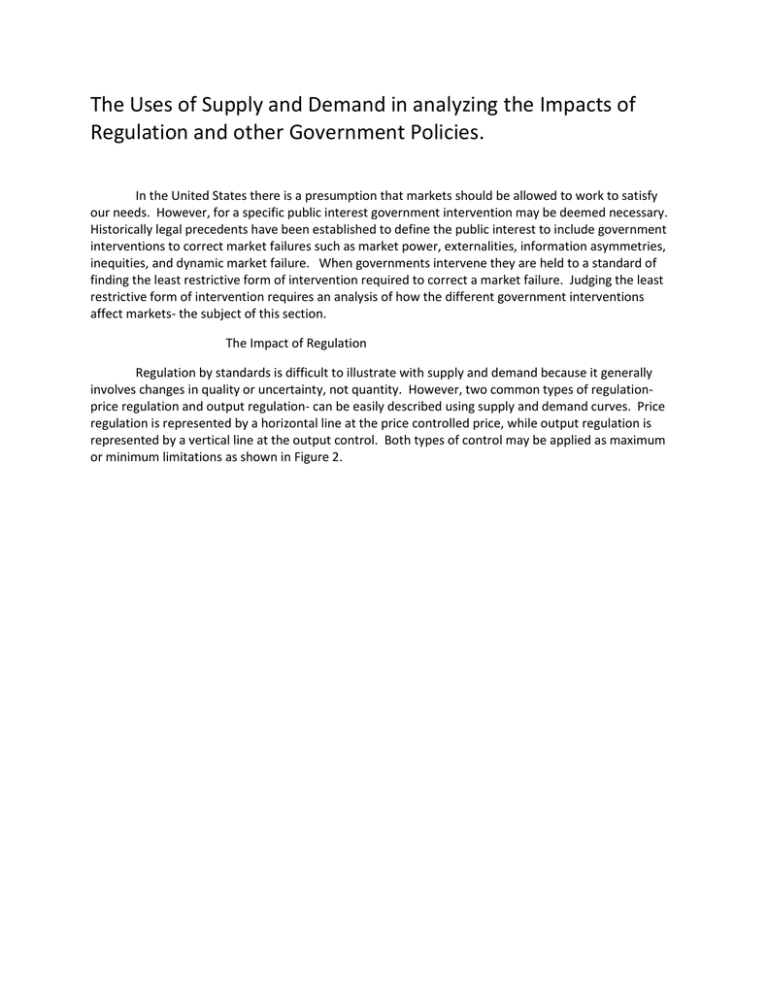The Uses of Supply and Demand in analyzing the Impacts... Regulation and other Government Policies.
advertisement

The Uses of Supply and Demand in analyzing the Impacts of Regulation and other Government Policies. In the United States there is a presumption that markets should be allowed to work to satisfy our needs. However, for a specific public interest government intervention may be deemed necessary. Historically legal precedents have been established to define the public interest to include government interventions to correct market failures such as market power, externalities, information asymmetries, inequities, and dynamic market failure. When governments intervene they are held to a standard of finding the least restrictive form of intervention required to correct a market failure. Judging the least restrictive form of intervention requires an analysis of how the different government interventions affect markets- the subject of this section. The Impact of Regulation Regulation by standards is difficult to illustrate with supply and demand because it generally involves changes in quality or uncertainty, not quantity. However, two common types of regulationprice regulation and output regulation- can be easily described using supply and demand curves. Price regulation is represented by a horizontal line at the price controlled price, while output regulation is represented by a vertical line at the output control. Both types of control may be applied as maximum or minimum limitations as shown in Figure 2. Figure 2. Disequilibria (“current price” indicates price to the Consumer due to Effective control) (a) (b) Current Price P Supply Demand (c) Current Price P Demand Supply (d) Current Price P Demand P Supply Quantity Quantity Current Price Quantity Demand Supply Quantity Minimum output constraints (Figure 2a) are typically applied by government to provide necessities to people who would not generally be reached by the market. Attempts to provide universal service in education, postal service, health care services, telecommunications, water, electricity and other utilities fall into this type of regulation. Invariably the government must subsidize such service because at such quantities, people will only be willing to pay what is shown on the demand curve, and suppliers will need to be paid what is on the supply curve. Minimum price controls (Figure 2b) are often called “price floors” because they prevent prices from falling through the floor. (But watch out! A “floor” suggests the price is below the equilibrium, but it’s not- it’s above the equilibrium, preventing the price from falling to the equilibrium). The price floor results in queues of goods- called inventories or stockpiles that are expensive and wasteful to store. They also result in excess capacity which someone must pay for. Market forces will take the form of businesses (or governments) trying to get rid of the excess between the quantity supplied and the quantity demanded at the dotted line. Maximum price controls (Figure 2c), by contrast, are referred to as “price ceilings” because they prevent prices from rising above the ceiling. The price ceiling results in queues of people, standing in line waiting for product. Such waiting is a waste of their time and effort and often leads to finding ways of obtaining a good on an illegal market. Invariably scalpers or smugglers will attempt to meet the unmet demand and they will do so at a price well above the equilibrium price in the legal market. That illegal price is often referred to as the “shadow price”- perhaps a better name would be the “shady” price because illegal markets are created to get around the price ceiling. Maximum output controls are the prohibitions or quotas that limit production as shown in figure 2d. In the case of quotas, the shadow price may be legal, but it will still be above the equilibrium price that would occur if the market were permitted to work without limitation. Invariably illegal markets will spring up to circumvent such prohibitions or limitations. Impacts of Other Government Interventions Many government interventions can be illustrated quite simply with supply and demand curve shits. Typically the government’s role in opening up information will lower information costs (i.e. price of resources) and therefore will shift the supply curve rightward or downward. However, when the government protects information by making it secret or private or if the government otherwise limits the use of the information, then the supply curve of firms can shift upward or leftward. The government can lower market power by encouraging entry of new firms into a market (i.e. increasing the number of sellers). However, if the government favors specific competitors it may actually contribute to the market power of those specific competitors at the expense of other participants in a market. Taxes and subsidies are determinants of supply and demand that shift the supply and demand curves. If taxes and subsidies are made to the buyer then the demand curve shifts. Taxes, like income taxes, shift the demand curve to the left while subsidies, like social security, given to consumers shift it to the right. If taxes and subsidies are made to the supplier, then the supply curve shifts. Taxes, like sales taxes on producers, shift the supply curve upward (to the left) while subsidies shift it downward (to the right). © copyright 2009 by Michael Tansey






